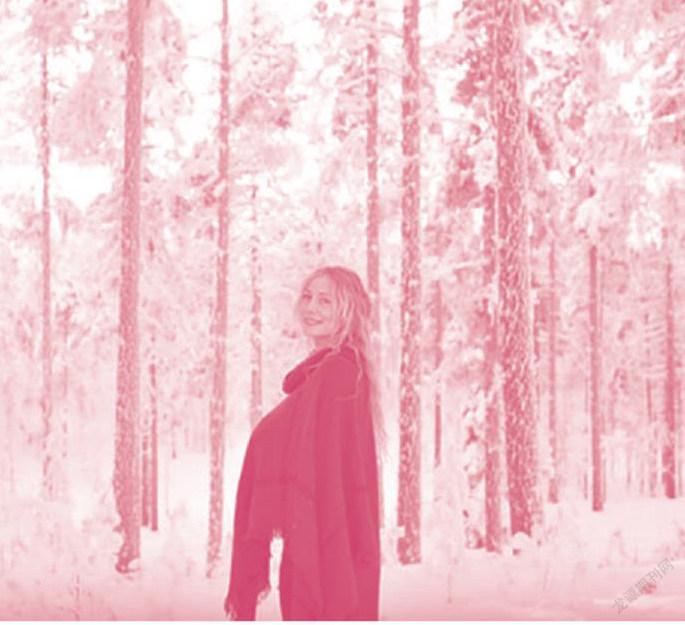Kulning: A Hypnotic Swedish Singing Tradition“库尔宁”:一种有魔力的瑞典歌唱传统
贾斯廷·考尔德伦 秦书未


Skallskog is a secluded farm without running water or electricity that most Swedes have never heard of. Hidden deep in the Nordic wilderness, this humble collection of cattle barns and russet-red farmhouses may seem like a place of little importance. But this is where youll find the disappearing roots of an ancient Swedish singing tradition so intimately connected to nature that it can only be described as magic.
Kulning is a vocalisation tradition that dates back to the Middle Ages, where singers corral1 farm animals with hypnotic melodies, luring cows, goats, sheep and ducks towards them as if each note was charged with its own gravity. This mystical ability originates from centuries-old f?bods2 (summer farms) like Skallskog, where farmwomen would traditionally call their meandering animals back home as they grazed freely during the few warm months in these frigid lands. In recent decades, as womens place in society has shifted, these sounds have transformed from farmland pragmatism3 to operatic4 ele-gance.
A kind of Nordic yodelling5-meets-Dr Doolittle6 superpower, modern Kulning has a bewitching quality that inspired Disney to include its entrancing melodies in Frozen 2. In 2016, YouTuber Jonna Jinton posted a video of her Kulning to cows that racked up more than eight million views. And outdoor concerts and folk music festivals featuring trained Kulning singers are continuing to popularise this spellbinding art of communicating with nature.
This form of herd-calling connects hyper-digital Sweden to its pastoral past. Yet, just as Swedes have become increasingly detached from the farm, the origins of Kulning have come close to being forgotten.
I visited Skallskog in late September as part of my search for a summer farm where Kulning was once routinely practiced.
“Kulning is a vocal technique born out of function. It happens across several regions in the Nordic countries. Norway, of course, but also historically in eastern Finland,” Jennie Tiderman-?sterberg, a trained opera singer and former punk rocker told me on the drive from the train station to the farm, explaining that the musical tradition started in the stubborn soil of Scandinavias frozen farmlands that made Kulning more necessity than art. Farmers here are migratory and herd their animals to f?bods during the summer months to graze on fresh grass. Unlike many herding cultures, Scandinavias shepherds were mostly women that employed high-pitched animal mimicry.
“The long, ornamented7 and melismatic8 calls are often directed towards cows. Goats and sheep have different sounds; often shorter, more rhythmical, and more guttural9,” she said, adding that the “magic” that makes Kulning work is a combination of controlling how ones voice travels across natural landscapes and a knowledge of animal calls.
Id arrived in Sweden just in time to attend one of Tiderman-?sterbergs last Kulning concerts of the season. The venue was a sunken silver mine in a hilly pine forest south of Borl?nge that provided the necessary natural acoustics. An audience of about 20 people set up camping chairs around an impossibly brilliant turquoise pool formed by the sunken mine, while she and two other female Kulning singers and a man with a cow horn spread out around us, facing away so as not to project directly at anyone.
In this sense, the outdoor setting is practical: “There are such strong sounds in Kulning you could make someone deaf if you use it in a room or even in a concert hall,” said Tiderman-?sterberg.
A piercing call suddenly burst through the majestic silence of the wilderness. Starting with an undulating melody from one of the singers hidden just beyond the tree line, the performers took turns calling their hypnotic chorus to invisible animals. The songs primordial force seemed to awaken something unseen. Birds chirped in response, or perhaps as an accompaniment. A natural echo added to the music. Tree leaves shook; whether it was the wind or spirits, I could not tell.
When it was Tiderman-?sterbergs turn, she rang a cowbell to help visualise the animals she was calling upon. “I need to hear the sound of the cattle to call on them, even if they are imaginary in an open-air concert,” she later told me. “But I can almost sense the smell of them and hear their bellowing when I hear the cowbell. They become a part of the sense-scape that creates the right feeling for me. Then I get in contact with all the women who sang before me in these forests. Its quite spiritual, real-ly.”
Alice Gustafsson, 81, is one of these women. She learned to walk at Skallskog many decades ago, and still marches her animals here every summer, a 20km walk from the farm in Dalarna that her family uses for the rest of the year.
Gustafssons relationship with her six cows—how she mimics their voices and cares for them—is a rare snapshot10 of what Kulning originally was. “I dont practice Kulning the way that many of us talk about [it] today, but I do communicate with the animals. I call on them, talk with them and sing to them, just as a way to relate,” she said. “They are part of my family.”
Today, Tiderman-?sterberg is tirelessly working to gain UNESCO Intangible World Heritage status for the Nordic f?bods and Kulning singing traditions.
Jinton concedes that “Kulning will never be the same way that it once was. It was from farmers calling the animals, but maybe now it can evolve, and we can benefit from it in another way.”
Jinton admits there is “something enchanting” about sharing her love for Kulning.
“It doesnt matter if you are from Sweden or Africa, Kulning gets the same reaction, no matter the culture,” she said. “I still dont know what it is. Perhaps it has something to do with this kind of sound and frequency that reminds us of something very ancient that has been locked away in our DNA for a long time.”
“This music helps people, it heals people. I think Kulning will continue to be good for us in this way.”
斯科爾斯科格农场是大多数瑞典人从未听说过的一处僻静的农场,这里没有自来水,也没有电。在北欧的荒野深处,这些不起眼的牛棚和红褐色农舍似乎显得微不足道。但就是在这里,有一种正在渐渐消亡的古老的瑞典歌唱传统,它同大自然有着十分紧密的联系,简直只能用神奇来形容。
这种歌唱传统就是“库尔宁”。其历史可以追溯到中世纪,那时的人们为了把动物赶进围栏,会唱起催眠小曲,诱使牛、山羊、绵羊、鸭子都朝他们走来,就好像每个音符都被赋予了引力似的。这种神奇的能力源自有着数百年历史的“夏日农场”,比如斯科尔斯科格农场。在这些严寒地区难得暖和的几个月里,“夏日农场”的女人们会习惯用歌声呼唤那些游荡着自在吃草的牲畜,让它们回家。最近几十年,随着女性社会地位的转变,这样的呼唤从一种牧民实用技能演变为一种高雅的歌唱艺术。
现代“库尔宁”融合了北欧约德尔唱法和杜立德医生的奇异能力,也给迪士尼的创作者们带来了灵感,他们将“库尔宁”迷人的旋律用在了《冰雪奇缘2》中。2016年,博主乔娜·金顿在优兔视频网站上发布了一则她向着牛群唱“库尔宁”的视频,获得了累计超过800万的播放量。一些户外音乐会和民间音乐节也会邀请受过相关训练的歌手来表演“库尔宁”,不断让这种令人沉醉的与大自然交流的艺术形式得到推广。
这样一种呼唤牧群的方式,让人仿佛从瑞典高度数字化的现代生活穿越回昔日的农牧生活。但是随着瑞典人越来越脱离农牧生活,“库尔宁”的原始形态已快要被人们淡忘。
为了找到一处曾时常有人唱“库尔宁”的“夏日农场”,我在九月末探访了斯科尔斯科格农场。
珍妮·蒂德曼-奥斯特贝格是一位受过专业训练的歌剧演员,她还曾经做过朋克摇滚乐手。开车从火车站去往农场的路上,她告诉我:“‘库尔宁是有实际功用的一种发声技术,在北欧国家的好几个地方都有,挪威当然有,历史上芬兰东部也曾有过。”她解释道,斯堪的纳维亚地区耕地冻结,土壤不适合农作物种植,在这里“库尔宁”与其说是艺术还不如说是必要技能,所以这一传统得以在此形成。这里的农民过着迁徙的生活,每到夏天,他们就到“夏日农场”去放牧,让牲畜吃到新鲜的草。和很多游牧文化不同的是,斯堪的纳维亚地区的牧羊人,大多是能模仿动物尖声叫唤的女性。
她接着说:“那种悠扬的、带有装饰音的歌声,通常是对牛唱的。对山羊和绵羊唱的话,声音就不一样,常常更短促,更有节奏性,更像喉音。”她还补充道,“库尔宁”之所以能奏效,秘诀在于既要懂得如何操控声音传遍四野,又要了解各种动物叫声。
我这次来瑞典,刚好赶上了蒂德曼-奥斯特贝格在这个季度最后的几场“库尔宁”音乐会之一。音乐会的表演场地是一处下陷的银矿,位于博伦厄南边、丘陵地带的一片松树林,这样的环境为表演提供了必要的天然音效。大约有二十来位观众,他们摆好折叠椅,围坐在这片由低洼的银矿形成、璀璨夺目的蓝绿色“乐池”四周。蒂德曼-奥斯特贝格和另外两位女歌手,以及一个戴着牛角的男人,四个人在我们周围分散站开,面朝外,以免过响的歌声直接冲击观众。
从这个意义上来说,室外的环境再合适不过了。“‘库尔宁的声音太大了,要是在房间里唱,甚至在音乐厅里唱,都会震耳欲聋的。”蒂德曼-奥斯特贝格说。
突然,一声尖锐的鸣唱划破这荒野的静穆。只听见一段起伏的旋律传来,原来是藏在林边的一位歌手唱的,然后演唱者一个接一个加入合唱,歌声令人迷醉,呼唤着不知在何处的动物们。这歌声的原始魔力似乎唤醒了某种看不见的东西。鸟儿叽叽喳喳地应和起来,也或许是给歌手们伴奏。大自然的回声也融进这音乐之中。树叶摇晃起来,到底是风还是幽灵,我说不清。
轮到蒂德曼-奥斯特贝格了,她摇响一只牛铃,这样便于自己想象出所要呼唤的动物。她后来告诉我:“要呼唤牛,我得听见它们的叫声才行,即便在户外音乐会上这些只能靠想象。但只要听见牛铃响,我仿佛就能闻到它们的气味,听见它们哞哞叫。这成了一种知觉的画面,带给我对的感觉。然后,我就会和森林里所有在我之前唱过的女歌手产生联系。这真的是一种奇妙的精神体验。”
81岁的阿莉塞·古斯塔夫松是这些女歌手中的一位。几十年前,她在斯科尔斯科格农场学会了放牧。现如今,每年夏天,她依然會把她的动物赶到这儿来放牧。这里距离她们家在达拉纳的农场步行要20公里,一年中的其他时间里,她们家就会使用那个农场。
古斯塔夫松和她的六头牛之间的关系——她模仿它们的叫声和照料它们的方式,就像一张珍贵的照片,记录了“库尔宁”最原始的形态。“我并不用如今很多人都在讲的那种方式演唱‘库尔宁,但是我的确在和动物们交流。我呼唤它们,和它们交谈,给它们唱歌,都是为了同它们保持一种联系。”她说,“它们是我的家人。”
目前,蒂德曼-奥斯特贝格正在不辞辛劳地为北欧的“夏日农场”和“库尔宁”歌唱传统争取着,以期联合国教科文组织将它们列入世界非物质文化遗产名录。
金顿承认说:“‘库尔宁将再也不会回到以前的形态了。它源于牧民们呼唤动物的传统,而如今它或许会发生演变,我们能以另一种方式从中受益。”
她还坦言,分享她对“库尔宁”的喜爱,是一件“还挺迷人的事儿”。
“不管你是来自瑞典还是非洲,无论你有怎样的文化背景,‘库尔宁都能唤起同样的感受。”她说,“我依然说不清这种感受到底是什么。或许它就跟这样一种声响和频率有关,而这种声响和频率,唤醒了我们基因中蕴藏已久的某种古老记忆。”
“这种音乐形态能够帮助人们,疗愈人们。我相信‘库尔宁将继续以这种方式造福我们。”
(译者为“《英语世界》杯”翻译大赛获奖者)
1 corral把(马或牛)赶入围栏(或关进畜栏)。 2 f?bod瑞典语,原义为“小木屋”。
3 pragmatism实用主义;务实思想;实用观点。 4 operatic歌剧的;和歌剧相关的。 5 yodelling约德尔唱法,一种歌唱形式,特点是伴随快速而重复进行胸音到头音转换的大跨度音阶。 6小说《杜立德医生》及同名电影中的虚构人物,是一位能和各种动物交谈的兽医。
7 ornament装饰;点缀;美化。 8 melismatic装饰音的;花唱式的。 9 guttural(似)喉间发出的。
10 = snap(尤指抢拍的)照片。

